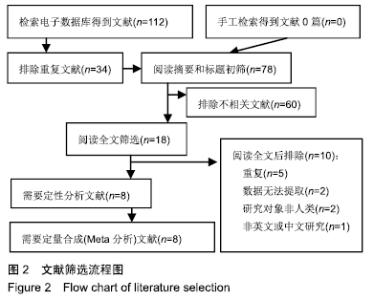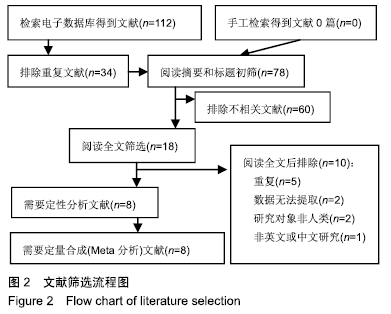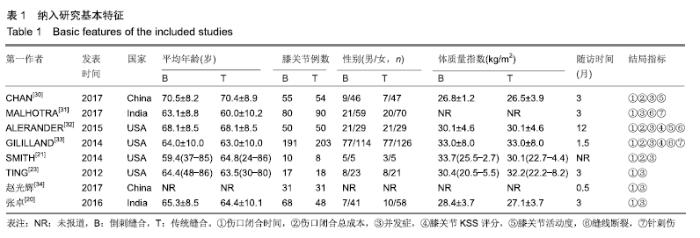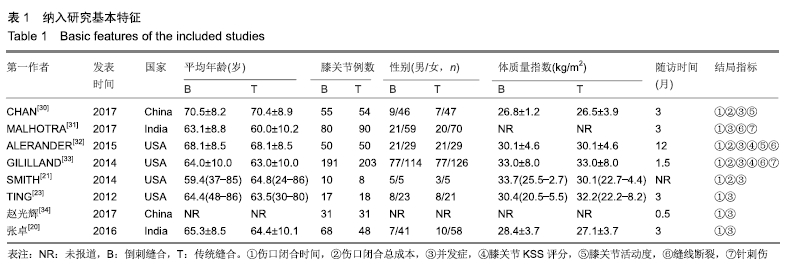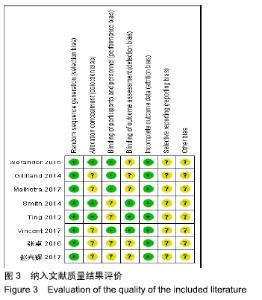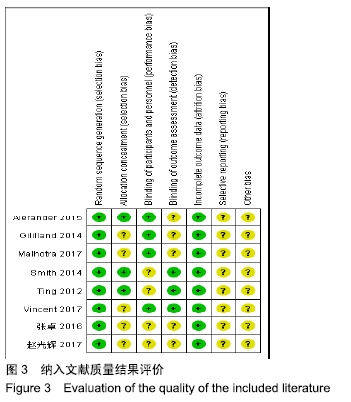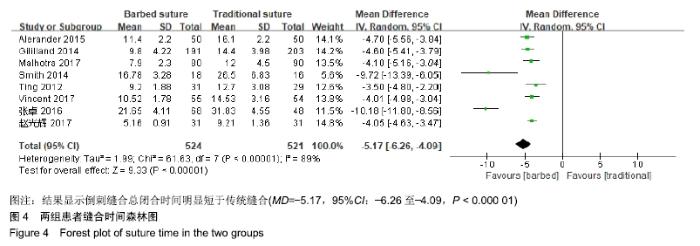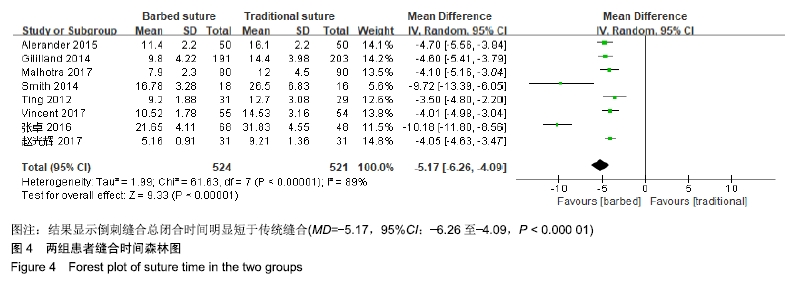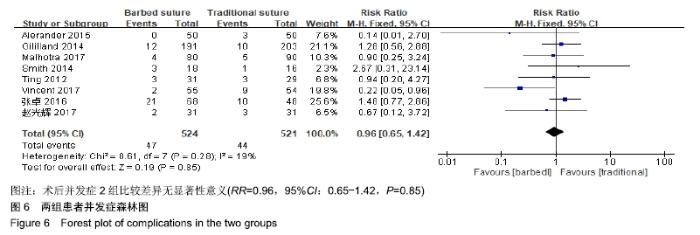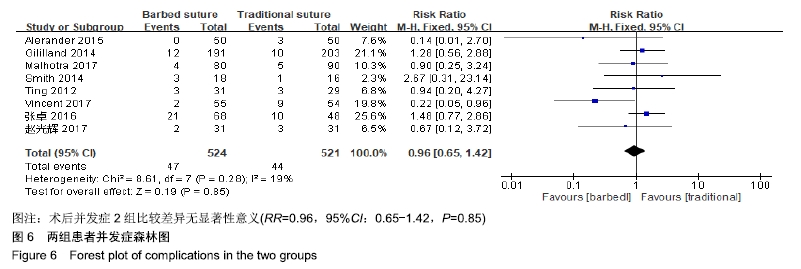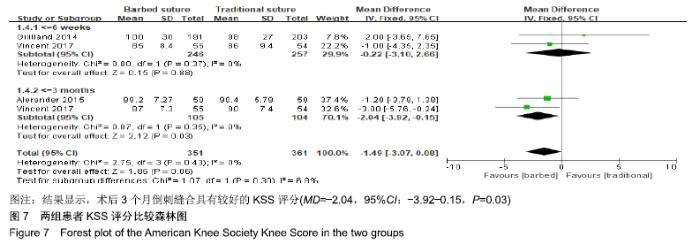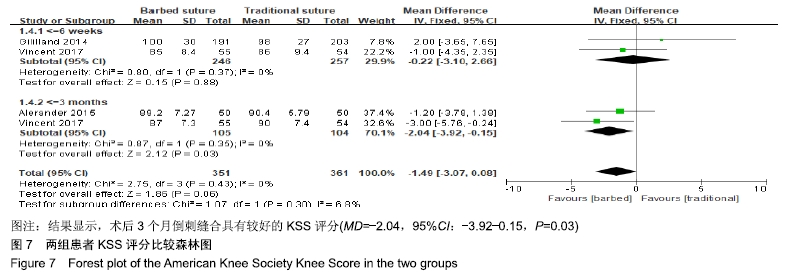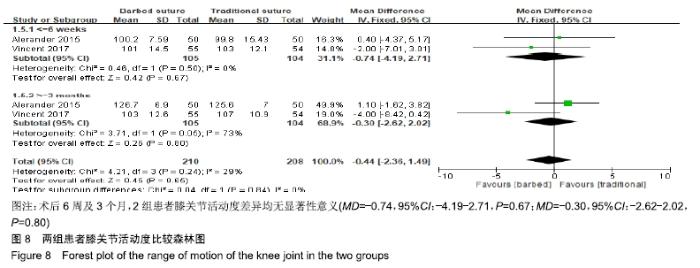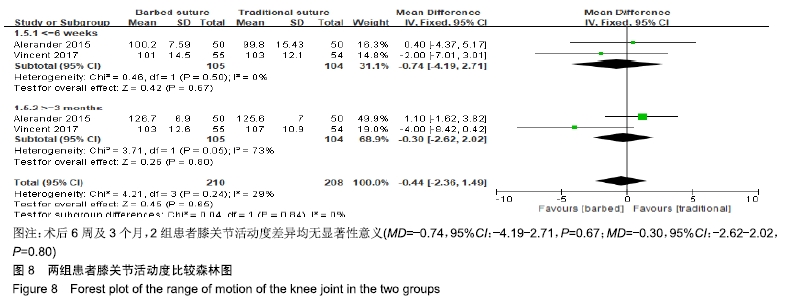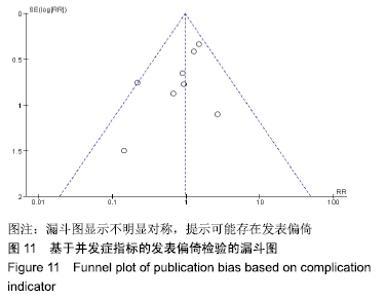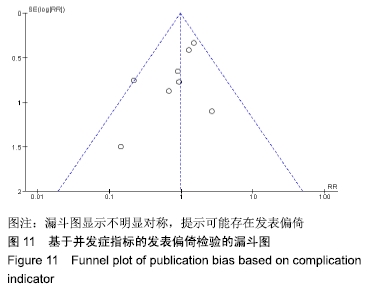Chinese Journal of Tissue Engineering Research ›› 2020, Vol. 24 ›› Issue (21): 3430-3437.doi: 10.3969/j.issn.2095-4344.2651
Previous Articles Next Articles
Meta-analysis of barbed suture versus traditional suture in primary total knee arthroplasty
Ma Xin1, Zhang Wenhui2, Yang Yuping2, Yuan Zhiguo3
- 1Medical College of Northwest Minzu University, Lanzhou 730000, Gansu Province, China; 2Department of Orthopedics, Gansu Provincial Hospital, Lanzhou 730000, Gansu Province, China; 3Department of Orthopedics, Gansu Provincial Second People’s Hospital, Lanzhou 730000, Gansu Province, China
-
Received:2019-08-27Revised:2019-08-30Accepted:2019-10-15Online:2020-07-28Published:2020-04-19 -
Contact:Ma Xin, Master candidate, Medical College of Northwest Minzu University, Lanzhou 730000, Gansu Province, China Zhang Wenhui, Master, Department of Orthopedics, Gansu Provincial Hospital, Lanzhou 730000, Gansu Province, China Ma Xin and Zhang Wenhui contributed equally to this work. -
About author:Ma Xin, Master candidate, Medical College of Northwest Minzu University, Lanzhou 730000, Gansu Province, China
CLC Number:
Cite this article
Ma Xin, Zhang Wenhui, Yang Yuping, Yuan Zhiguo. Meta-analysis of barbed suture versus traditional suture in primary total knee arthroplasty[J]. Chinese Journal of Tissue Engineering Research, 2020, 24(21): 3430-3437.
share this article
| [1] KURTZ S, ONG K, LAU E, et al. Projections of primary and revision hip and knee arthroplasty in the United States from 2005 to 2030 . J Bone Joint Surg Am. 2007;89A(4): 780-785. [2] OLESKE DM, BONAFEDE MM, JICK S, et al. Electronic health databases for epidemiological research on joint replacements: considerations when making cross-national comparisons. Ann Epidemiol.2014;24(9):660-665. [3] Swedish Knee Arthroplasty Register Annual Report 2014. http://www.myknee.se/pdf/SKAR2014-Eng-11.pdf [accessed 13.03.16]. [4] KURTZ SM, LAU E, ONG K, et al. Future young patient demand for primary and revision joint replacement: national projection from 2010-2030. Clin Orthop Relat Res.2009; 467(10):2602. [5] PATEL RM, CAYO M, PATEL A, et al. Wound complications in joint arthroplasty: comparing traditional and modern methods of skin closure . Orthopedics. 2012;35(5): E641-E646. [6] ZHANG W, XUE DT, YIN HF, et al. Barbed versus traditional sutures for wound closure in knee arthroplasty: a systematic review and meta-analysis. Sci Rep. 2016;6: 19764. [7] NARANJE S, LENDWAY L, MEHLE S, et al. Does operative time affect infection rate in primary total knee arthroplasty? Clin Orthop Relat Res. 2015;473(1):64-69. [8] MURTHA AP, KAPLAN AL, PAGLIA MJ, et al. Evaluation of a novel technique for wound closure using a barbed suture. Plast Reconstr Surg.2006;117:1769-1780. [9] MEYER R, SIVAN E, SHARON N, et al. Infectious morbidity following cesarean deliveries: a comparison of barbed to standard suture for myometrial closure. Am J Obstetrics Gynecol.2018;218(1): S335-S336. [10] CORTEZ R, LAZCANO E, MILLER T, et al. Barbed sutures and wound complications in plastic surgery: an analysis of outcomes . Aesthetic Surg J.2015;35(2):178-188. [11] ONI G, BROWN SA, KENKEL JM, et al. A comparison between barbed and non-barbed absorbable suture for fascial closure in a porcine model. Plasty Reconstr Surg. 2012; 130(4): 535e. [12] NETT M, AVELAR R, SHEEHAN M, et al. Water-tight knee arthroplasty closure: comparison of a novel single bidirectional barbed self-retaining running suture versus conventional interrupted sutures. J Knee Surg. 2011; 24:25. [13] BORZIO RW, PIVEC R,KAPADIA BH, et al. What is the evidence? A meta-analysis. Int Orthop. 2016;40(2): 225-231, 236. [14] CAMPBELL AL, PATRICK DA JR, LIABAUD B, et al. Superficial wound closure complications with barbed sutures following knee arthroplasty. J Arthroplasty. 2014;29(5): 966-969. [15] CHAWLA H, VANDER LIST JP, FEIN NB, et al. Barbed suture is associated with increased risk of wound infection after unicompartmental knee arthroplasty. J Arthroplasty.2016; 31(7): 1561-1567. [16] GE L, TIAN JH, LI YN, et al. Association between prospective registration and overall reporting and methodological quality of systematic reviews: a meta-epidemiological study. J Clin Epidemiol.2018;93:45-55. [17] TIAN JK, ZHANG J, GE L, et al. The methodological and reporting quality of systematic reviews from China and the USA are similar. J Clin Epidemiol.2017;85:50-58. [18] YAO L, SUN R, CHEN YL, et al. The quality of evidence in Chinese meta-analyses needs to be improved. J Clin Epidemiol. 2016;74:73-79. [19] 许宏,谢锦伟,雷一霆,等. 免打结倒刺缝线在初次全膝关节置换术中应用的荟萃分析[J].中国矫形外科杂志, 2018,26(16): 1472-1478. [20] 张卓,周永刚,林峰,等. 可吸收倒刺缝合线在人工全膝关节置换术中应用的病例对照研究[J].中国骨伤,2018,29(9):809-813. [21] SMITH EL, DISEGNA ST, SHUKLA PY, et al. Barbed versus traditional sutures: closure time, cost, and wound related outcomes in total joint arthroplasty. J Arthroplasty.2014; 29: 283-287. [22] 王亚飞,廖云建,刘慧敏,等. 可吸收倒刺缝线与传统可吸收缝线在全膝关节置换术中应用效果的Mete分析[J].中国循证医学杂志,2018,18(10):1101-1108. [23] TING NT, MORIC MM, DELLA VALLE CJ, et al. Use of knotless suture for closure of total hip and knee arthroplasties. J Arthroplasty. 2012;27(10):1783-1788. [24] HAN Y, YANG W, PAN J, et al. The efficacy and safety of knotless barbed sutures in total joint arthroplasty: a meta-analysis of randomized-controlled trials. Arch Orthop Trauma Surg. 2018;138:1335-1345. [25] MOHER D, LIBERATI A, TETZLAFF J, et al. Preferred reporting items for systematic reviews and meta-analyses: the PRISMA statement. PLoS Med. 2009;6(7): e1000097. [26] YAN P, YAO L, LI H, et al. The methodological quality of robotic surgical meta-analyses needed to be improved: a cross-sectional study. J Clin Epidemiol.2019;109:20-29. [27] PIEPER D, BUECHTER RB, LI L, et al. Systematic review found AMSTRA, but not R(evised)-AMSTAR, to have good measurement properties. J Clin Epidemiol.2015;68(5): 574-583. [28] LUNDH A, GOTZSCHE PC. Recommendations by Cochrane Review Groups for assessment of the risk of bias in studies. BMC Med Res Methodol. 2008;8:22. [29] HIGGINS JP, THOMPSON SG, DEEKS JJ, et al. Measuring inconsistency in meta-analyses. BMJ. 2003;327(7414): 557-560. [30] CHAN VWK, CHAN PK, CHIU KY, et al. Dose barbed suture lower cost and improve outcome in total knee arthroplasty? A randomized controlled trial. J Arthroplasty. 2017;32: 1474-1477. [31] MALHOTRA R, JAIN V, KUMAR V, et al. Evaluation of running knotless barbed suture for capsular closure in primary total knee arthroplasty for osteoarthritis-a prospective randomized study. Int Orthop. 2017;41:2061-2066. [32] ALEXANDER P, SAH MD. Is there an advantage to knotless barbed suture in TKA wound closure? a randomized trial jin simultaneous bilateral TKAs. Clin Orthop Relat Res. 2015; 437:201-202. [33] GILILLAND JM, ANDERSON LA, BARNEY JK, et al. Barbed versus standard sutures for closure in total knee arthroplasty: a multicenter prospective randomized trial. J Arthroplasty. 2014;29:135-138. [34] 赵光辉,马建兵,马致远,等.倒刺缝线在初次全膝关节置换术中的随机对照研究[J].实用骨科杂志,2017,23(9):827-829. [35] RUBIN JP, HUNSTAD JP, POLYNICE A, et al. A multicenter randomized controlled trial comparing absorbable barbed sutures versus conventional absorbable sutures for dermal closure in open surgical procedures. Aesthetic Surg J. 2014;34(2):272-283. [36] ROSENBERG AG. The use of a barbed suture in hip and knee replacement wound closure. Semi Arthroplasty. 2013; 24:132-134. [37] EICKMANN T, QUANE E. Total knee arthroplasty closure with barbed suture. J Knee Surg.2010;23(3):163-167. [38] URQUHRT DM, HANNA FS, BRENNAN SL, et al. Incidence and risk factors for deep surgical site infection after primary total hip arthroplasty: a systematic review . J Arthroplasty. 2010;25(8):1211-1222. [39] NAMBA RS, INACIO MC, PAXTON EW. Risk factors associated with deep surgical site infections after primary total knee arthroplasty: an analysis of 56,216 knees. J Bone Joint Surg Am.2013;95(9):775-782. [40] MAHESWARI AV, NAZIRI Q, WONG A, et al. Barbed suture in total knee arthroplasty: are these safe, efficacious and cost-efffective? J Knee Surg.2015;28(2):151-156. [41] MACARIO A. What dose one minute of operating room time cost? J Clin Anesth.2010;22(4):233-236. [42] LI R, NI M, ZHAO J, et al. A modified strategy using barbed sutures for wound closure in total joint arthroplasty: a prospective, randomized, double-blind, self-controlled clinical trial. Clin Res. 2018;24,8401-8407. [43] MEENA S, GANGARY S, SHARMA P, et al.Barbed versus standard sutures in total knee arthroplasty: A meta-analysis. Eur J Orthop Surg Traumatol. 2015;25: 1105-1110. [44] WRIGHT RC, GILLIS CT, YACOUBIAN SV, et al. Extensor mechanism repair failure with use of bidirectional barbed suture in total knee arthroplasty. JOA. 2012;27(7): 1413e1-1413e4. [45] ZARUBY J, GINGRAS K, TAYLOR J, et al. An in vivo comparison of barbed suture device sand conventional monofilament sutures for cosmetic skin closure: biomechanical wound strength and histology. Aesthetic Surg J.2011;31(2):232-240. |
| [1] | Hu Kai, Qiao Xiaohong, Zhang Yonghong, Wang Dong, Qin Sihe. Treatment of displaced intra-articular calcaneal fractures with cannulated screws and plates: a meta-analysis of 15 randomized controlled trials [J]. Chinese Journal of Tissue Engineering Research, 2021, 25(9): 1465-1470. |
| [2] | Huang Dengcheng, Wang Zhike, Cao Xuewei. Comparison of the short-term efficacy of extracorporeal shock wave therapy for middle-aged and elderly knee osteoarthritis: a meta-analysis [J]. Chinese Journal of Tissue Engineering Research, 2021, 25(9): 1471-1476. |
| [3] | Wang Jinjun, Deng Zengfa, Liu Kang, He Zhiyong, Yu Xinping, Liang Jianji, Li Chen, Guo Zhouyang. Hemostatic effect and safety of intravenous drip of tranexamic acid combined with topical application of cocktail containing tranexamic acid in total knee arthroplasty [J]. Chinese Journal of Tissue Engineering Research, 2021, 25(9): 1356-1361. |
| [4] | Zhou Jihui, Li Xinzhi, Zhou You, Huang Wei, Chen Wenyao. Multiple problems in the selection of implants for patellar fracture [J]. Chinese Journal of Tissue Engineering Research, 2021, 25(9): 1440-1445. |
| [5] | Chen Junming, Yue Chen, He Peilin, Zhang Juntao, Sun Moyuan, Liu Youwen. Hip arthroplasty versus proximal femoral nail antirotation for intertrochanteric fractures in older adults: a meta-analysis [J]. Chinese Journal of Tissue Engineering Research, 2021, 25(9): 1452-1457. |
| [6] | Chen Jinping, Li Kui, Chen Qian, Guo Haoran, Zhang Yingbo, Wei Peng. Meta-analysis of the efficacy and safety of tranexamic acid in open spinal surgery [J]. Chinese Journal of Tissue Engineering Research, 2021, 25(9): 1458-1464. |
| [7] | Wang Yongsheng, Wu Yang, Li Yanchun. Effect of acute high-intensity exercise on appetite hormones in adults: a meta-analysis [J]. Chinese Journal of Tissue Engineering Research, 2021, 25(8): 1305-1312. |
| [8] | Kong Desheng, He Jingjing, Feng Baofeng, Guo Ruiyun, Asiamah Ernest Amponsah, Lü Fei, Zhang Shuhan, Zhang Xiaolin, Ma Jun, Cui Huixian. Efficacy of mesenchymal stem cells in the spinal cord injury of large animal models: a meta-analysis [J]. Chinese Journal of Tissue Engineering Research, 2021, 25(7): 1142-1148. |
| [9] | Yuan Jun, Yang Jiafu. Hemostatic effect of topical tranexamic acid infiltration in cementless total knee arthroplasty [J]. Chinese Journal of Tissue Engineering Research, 2021, 25(6): 873-877. |
| [10] | Huang Dengcheng, Wang Zhike, Cao Xuewei. Intravenous, topical tranexamic acid alone or their combination in total knee arthroplasty: a meta-analysis of randomized controlled trials [J]. Chinese Journal of Tissue Engineering Research, 2021, 25(6): 948-956. |
| [11] | Li Yan, Wang Pei, Deng Donghuan, Yan Wei, Li Lei, Jiang Hongjiang. Electroacupuncture for pain control after total knee arthroplasty: a meta-analysis [J]. Chinese Journal of Tissue Engineering Research, 2021, 25(6): 957-963. |
| [12] | He Xiangzhong, Chen Haiyun, Liu Jun, Lü Yang, Pan Jianke, Yang Wenbin, He Jingwen, Huang Junhan. Platelet-rich plasma combined with microfracture versus microfracture in the treatment of knee cartilage lesions: a meta-analysis [J]. Chinese Journal of Tissue Engineering Research, 2021, 25(6): 964-969. |
| [13] | Hua Haotian, Zhao Wenyu, Zhang Lei, Bai Wenbo, Wang Xinwei. Meta-analysis of clinical efficacy and safety of antibiotic artificial bone in the treatment of chronic osteomyelitis [J]. Chinese Journal of Tissue Engineering Research, 2021, 25(6): 970-976. |
| [14] | Zhan Fangbiao, Cheng Jun, Zou Xinsen, Long Jie, Xie Lizhong, Deng Qianrong. Intraoperative intravenous application of tranexamic acid reduces perioperative bleeding in multilevel posterior spinal surgery: a meta-analysis [J]. Chinese Journal of Tissue Engineering Research, 2021, 25(6): 977-984. |
| [15] | Zhao Zhongyi, Li Yongzhen, Chen Feng, Ji Aiyu. Comparison of total knee arthroplasty and unicompartmental knee arthroplasty in treatment of traumatic osteoarthritis [J]. Chinese Journal of Tissue Engineering Research, 2021, 25(6): 854-859. |
| Viewed | ||||||
|
Full text |
|
|||||
|
Abstract |
|
|||||
